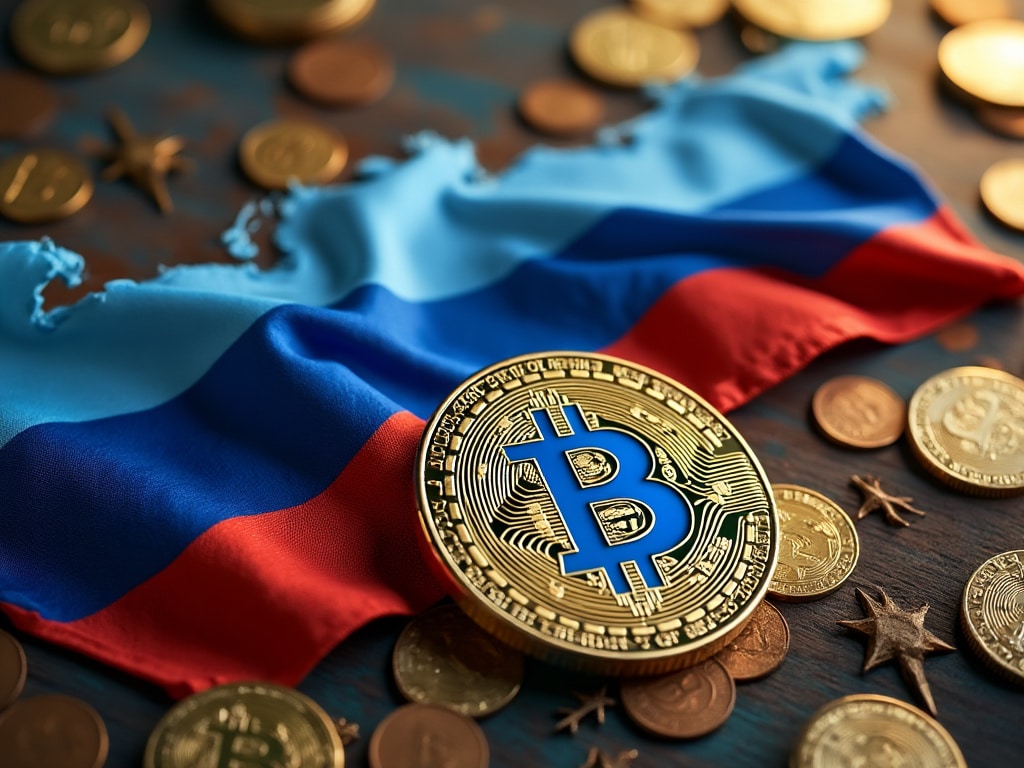Russia’s Crypto Gamble: A Lifeline or a Risky Strategy?

Russia's Crypto Gamble
Russia’s growing reliance on cryptocurrencies to evade international sanctions and the depreciating ruble reflects both innovation and risk. As the Kremlin continues to grapple with a deteriorating economy due to sanctions and war, its pivot toward digital currencies like Bitcoin and USDT has raised both optimism and concerns.
In this article, we will explore how cryptocurrencies are being used to bypass sanctions, mitigate economic pressures, and the critical challenges Russia faces in its bold shift.
Cryptocurrencies as a Sanctions-Evasion Tool
One of Russia’s primary motivations for integrating cryptocurrencies into its financial system is the ability to bypass Western financial sanctions. Following the 2022 invasion of Ukraine, sanctions severely limited Russia’s access to traditional banking networks and restricted its use of the U.S. dollar in international trade. As a result, the Kremlin has sought alternative payment methods, including the use of stablecoins and decentralized finance to enable cross-border transactions without relying on the U.S. dollar.
A prominent example of this shift is Russia’s increasing use of USDT (Tether), a stablecoin tied to the U.S. dollar (or so it claims), for cross-border payments. These digital assets enable Russia to settle transactions with countries like China and Iran, reducing its dependence on Western financial systems. As one expert noted, “Russia’s move to integrate crypto into its financial system may improve its ability to bypass the U.S.-led financial system…but the associated risks, including regulatory crackdowns and the volatility of crypto markets, make it a complex and uncertain strategy”.
Limited Liquidity: A Major Bottleneck
Despite these efforts, the global cryptocurrency market’s liquidity remains a major constraint for Russia. Compared to countries like Iran, which has also used cryptocurrencies to evade sanctions, Russia’s economic needs are far larger. According to a CSIS report, “Russia’s import demand is almost 10 times greater than that of Iran,” meaning that cryptocurrencies would have to be used on a much larger scale to meet these needs.
Furthermore, the global cryptocurrency market, valued at around $2 trillion, is simply too small to accommodate Russia’s large-scale financial operations. As noted by Chainalysis, large-scale on-chain sanctions avoidance is unlikely due to the lack of liquidity. Daily Bitcoin transactions account for less than 1% of daily SWIFT transactions globally, illustrating the significant gap between traditional finance and cryptocurrencies in terms of volume. This liquidity issue limits the utility of crypto for large-scale imports and could leave Russia facing serious economic shortfalls.
Mining as a Revenue Stream
Russia’s abundant energy resources have also made it a major player in the global cryptocurrency mining industry. The country sees crypto mining as a way to convert excess energy into digital assets that can be traded globally, creating an additional revenue stream despite sanctions on its energy exports. A new law passed in 2024 further legitimized mining activities, positioning Russia as a potential leader in the global cryptocurrency mining space.
However, this strategy is not without its challenges. As noted by CSIS, “Russia’s leadership in mining would allow the Kremlin to use cryptocurrencies to make up for its lost revenues.” Still, the global market might not be able to accommodate the scale needed for Russia’s economic goals.
Cybersecurity and Illicit Activity Risks
In addition to liquidity concerns, Russia’s increasing reliance on cryptocurrencies raises significant cybersecurity risks. Cryptocurrencies have long been associated with illicit activities, including cyberattacks, fraud, and money laundering. North Korea, for example, has used crypto-based cyberattacks to evade sanctions and generate revenue. Similarly, there is concern that Russian government-affiliated actors could engage in illegal activities to avoid sanctions.
As Chainalysis pointed out, “Government-affiliated actors…include fundraisers supporting pro-Russian militants in Ukraine” and facilitators helping oligarchs move capital abroad through cryptocurrencies, bypassing traditional financial sanctions. Moreover, Russia’s use of instant exchangers—platforms that do not require KYC (Know Your Customer) protocols—further complicates regulatory oversight and could lead to increased scrutiny from international bodies.
Geopolitical Isolation and Skepticism from Allies
While Russia has formed closer ties with countries like China and Iran, its reliance on cryptocurrencies could deepen its geopolitical isolation. Many of Russia’s trading partners remain wary of using volatile digital assets for significant transactions. Chainalysis reported that although Russia’s crypto pivot could strengthen ties with non-Western nations, there is still skepticism about cryptocurrencies’ viability for macroeconomic operations.
The volatile nature of cryptocurrencies, exemplified by the massive market crash in November 2022, further deters large-scale adoption. As a result, while Russia may be able to use crypto for smaller-scale transactions, it is unlikely to replace the more established financial systems it is cut off from.
A Supplementary, Not Transformative, Strategy
Russia’s cryptocurrency strategy, while innovative, faces considerable challenges. The limited liquidity of global crypto markets, combined with cybersecurity risks and global regulatory pressures, make large-scale sanctions evasion and macroeconomic stability difficult to achieve through cryptocurrencies alone. As Techopedia aptly summarizes, “The associated risks, including regulatory crackdowns and the volatility of crypto markets, make it a complex and uncertain strategy”.
In the short term, cryptocurrencies may help Russia generate revenue and maintain some trade, but they are unlikely to replace traditional financial systems. The long-term success of this strategy will depend on how effectively Russia can navigate these challenges while avoiding further geopolitical and economic isolation. For now, Russia’s crypto pivot remains a supplementary, rather than a transformative, solution to its financial woes.





